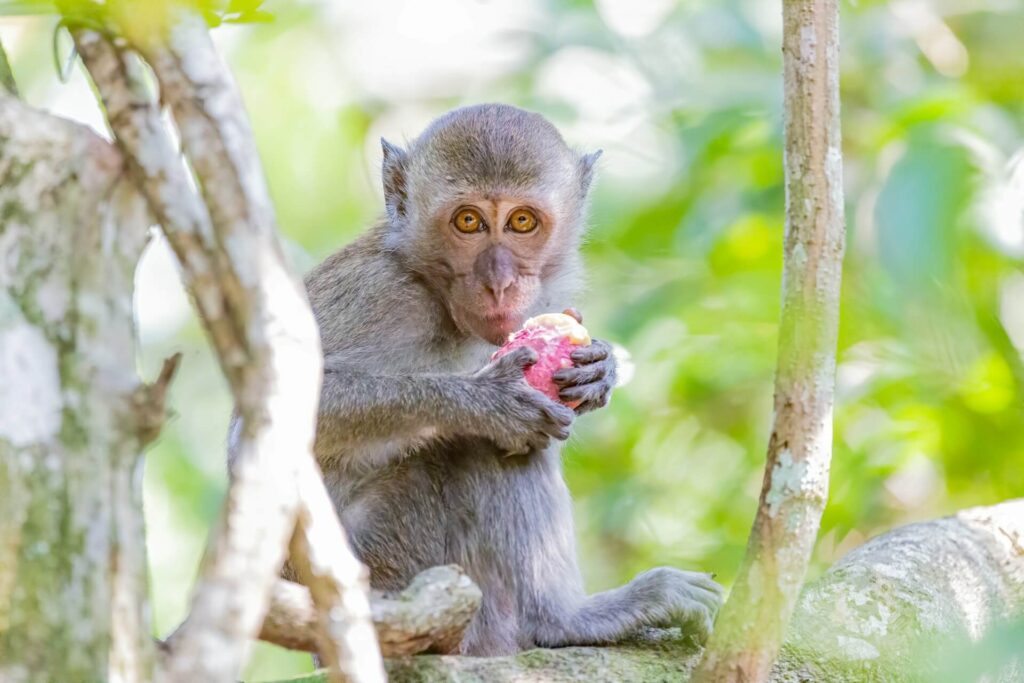Monkeys are playful primates and are known for being smart, agile, and mischievous. In this article, we will explore the world of monkeys and share some incredible and enjoyable fun facts about monkeys for kids.

10 Fun facts about monkeys for kids
- Monkeys come in all shapes and sizes: From the tiny pygmy marmoset, which is the size of a human hand, to the mighty gorilla, which can stand up to six feet tall, there is a wide variety of monkeys in the animal kingdom.
- Monkeys are excellent climbers: With their long limbs and flexible tails, monkeys are built for life in the trees. They can effortlessly swing from branch to branch and leap long distances.
- Monkeys are social animals: They live in groups called troops or bands. These groups can range from a few individuals to several dozen monkeys. Living in a troop helps monkeys protect themselves from predators and find food more easily.
- Monkeys have a diverse diet: Depending on the species, monkeys eat a variety of foods, including fruits, leaves, nuts, insects, and even small animals. Their diet is often influenced by their habitat and the availability of food sources.
- Monkeys are found all over the world: While many people associate monkeys with tropical rainforests, they can be found in a wide range of habitats, including forests, grasslands, and even mountains. Some species, like the Japanese macaque, can even survive in snowy conditions.
- Monkeys use tools: Some species of monkeys, such as the capuchin monkey, have been observed using tools to help them obtain food. They may use sticks to dig for insects or rocks to crack open nuts.
- Monkeys have unique features: Monkeys have a wide array of physical characteristics that set them apart from other animals. From their long tails to their dexterous hands, each feature has evolved to help them survive in their specific environment.
- Monkeys communicate in different ways: Monkeys use a combination of vocalizations, facial expressions, and body movements to communicate with each other. Some species, like the howler monkey, are known for their loud and distinctive calls that can be heard from miles away.
- Monkeys are intelligent creatures: They have been known to solve puzzles, use tools, and even learn sign language. Their ability to problem-solve and adapt to new situations is a testament to their intelligence.
- Monkeys play a vital role in their ecosystems: As seed dispersers, monkeys help maintain the balance of their habitats by spreading the seeds of the fruits they eat. They also serve as prey for other animals, contributing to the intricate web of life in their ecosystems.

Where do monkeys live?
Monkeys are found in different parts of the world, such as the rainforests of South America, the jungles of Asia, and the savannas of Africa. Each species of monkey has its own preferred habitat, depending on factors like climate, food availability, and the presence of predators.
In the rainforests of Central and South America, you can find monkeys like the spider monkey and the howler monkey. These monkeys thrive in dense vegetation and high canopies that provide them with plenty of food and protection from predators.

In Africa, you can find iconic monkeys like the chimpanzee and gorilla in the dense forests of Central and West Africa. These primates need large undisturbed forest areas to meet their dietary and social needs.

Asia is home to various monkey species, including playful macaques and langurs. These monkeys can be found in different habitats, from tropical rainforests to mountainous regions.

What do monkeys eat?
Monkeys have a wide range of diets depending on their species and habitat. Some monkeys mainly eat plants, while others eat a mix of plants and animals. Monkeys are omnivores, which means they eat both plants and animals. Their diet typically includes fruits, leaves, insects, and sometimes small animals.
Many monkeys eat fruits and leaves, using their sense of smell to find ripe fruits and edible leaves. Some monkeys, like squirrel monkeys, also eat insects and small invertebrates. Certain monkeys, such as capuchin monkeys, are known for using stones or other hard objects to crack open nuts. This shows their intelligence and adaptability in finding food.
The monkey’s diet is closely connected to its habitat. Monkeys in rainforests have access to many different fruits and nuts, while those in grasslands may rely more on leaves and insects.

Different species of monkeys
There are over 260 species of monkeys in the world, each with its own unique characteristics and adaptations. Some of the most well-known species include:
- Chimpanzees: Known for their high level of intelligence and ability to use tools, chimpanzees are found in the forests of Central and West Africa.

- Gorillas: The largest species of primate, gorillas are gentle giants that inhabit the forests of Central Africa.

- Orangutans: These great apes are native to the rainforests of Borneo and Sumatra. They are known for their distinctive reddish-brown hair and incredible strength.

- Spider monkeys: With their long limbs and prehensile tails, spider monkeys are expert climbers. They can be found in the rainforests of Central and South America.

- Macaques: Macaques are a diverse group of monkeys that can be found in various parts of Asia. They are known for their adaptability and ability to live in a wide range of habitats.

These are some examples of the many different kinds of monkeys in the world. Each species has its own special traits and behaviors that make them unique creatures.
Did you know that a group of monkeys is typically called a “troop.”
Monkey communication and intelligence
Monkeys are very social animals and have developed complex ways to communicate with each other. They use sounds, facial expressions, and body movements to send messages and establish social hierarchies.
Different monkey species have their own unique sounds for different purposes. Some use loud calls to talk to other members of their group, while others use soft, low-pitched sounds to signal danger or mating opportunities.
Monkeys also use facial expressions to show their emotions and intentions. For example, a bared grin can mean submission, while wide-eyed staring can indicate aggression.
Monkeys are also very smart and adaptable. They have been seen using tools to get food, solve puzzles, and even learn sign language. Their ability to learn from experience and solve problems shows how smart they are.
Conclusion: Embrace your inner explorer with fascinating facts about monkeys!
Monkeys are fascinating creatures that capture our imagination. They are playful, adaptable, and intelligent primates. This article presents fun facts about monkeys to help children appreciate nature and explore their curiosity. Remember their amazing adaptations, unique features, and social behaviors that make them fascinating. Monkeys have a diverse diet, use tools, and have complex communication systems, showcasing the wonders of the animal kingdom. Let your curiosity guide you as you learn more about the world of monkeys!


Leave a Reply